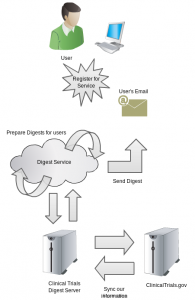In order to tackle the problem of low clinical trial accrual, my group has decided to work on designing the general solution of a Clinical Trials Navigator (CTN). While I am satisfied with this as a good general solution, there are other specific solutions that could be beneficial. Especially being a computer science major who loves to build software, I can’t help but toy with these other solutions. So just for fun, I will change gears and write a slightly more technical blog post that describes the architecture for a solution that I would like to implement in the future (when I have time!).
The idea is a service that sends patients email digests for new trials that are relevant to them. A digest contains a simple list of potential clinical trials that the patient might qualify for, and is interested in. The flow of the application is described below.
Basic Architecture
The use case for a user is that they register online for the digest service and choose the corresponding types of trials that they would be interested in. After this simple registration, the user does not have to initiate any more contact with the service. From the user’s perspective, digests with aggregated clinical trials information will come in at a fairly steady pace. This saves the patient from the headache of sifting through trials themselves.
But how does the user receive this neat packaged digest of relevant clinical trials? The solution I have thought up is simple:
-
The listing of all clinical trials on clinicaltrials.gov is freely available and is updated every day. The end goal is to detect new trials, so what we will do is index all current trials, and then check every day to see if there are non-indexed trials (which means they are new).
-
When new trials are added, we check against our database of registered users to check whether or not the trials would be relevant. If they would be, then we make a note to include the trial in the user’s next digest.
-
Once a digest has reached a tipping point (a point where any more trials would clutter the digest) or a time of inactivity (below the tipping point, but there are trials that are getting stale), then we send the user the email digest.
-
In the email the user has the option to unsubscribe themselves from the digest.
Although this solution does not help patients who are not already engaged patients, I hope that it might help those who are not against the idea of trials, but have not the energy, time, or knowledge to sift through trials online.

